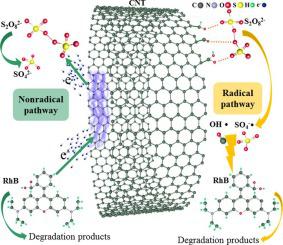Separation and Purification Technology ( IF 8.1 ) Pub Date : 2020-09-25 , DOI: 10.1016/j.seppur.2020.117788 Shaohua Chen , Liying Ma , Yaguang Du , Wei Zhan , Tian C. Zhang , Dongyun Du

|
Recently, sulfate radical (E0 = 2.60 V) generated by the activation of persulfate (PS) has been reported to be effective in destructing recalcitrant organic contaminants. However, conventional PS activation methods (e.g., via heat, UV or carbon-base materials) need high energy input or may cause secondary contamination (due to the use of transition metals). In the present study, a novel system with PS activated by metal-free carbon-nanotubes (CNTs) was developed. Results indicate that CNTs could efficiently activate PS for degradation of RhB (e.g., 100% removal with 150 min) with low concentrations of PS at the initial pH range of 3–9. The removal efficiency of RhB increased with an increase in CNTs dosage and PS concentration. The coexistence of natural organic matter (NOM) in the natural environment significantly promoted the degradation of RhB. Both radical and non-radical pathway could activate PS by CNTs, but non-radical pathway was dominated. PS can be activated by the oxygen-containing groups on the surface of CNTs to generate hydroxyl radical () and sulfate radicalMeanwhile, the electron transfer process among PS, RhB and CNTs was confirmed by PS decomposition and linear sweep voltammetry (LSV) experiments. Furthermore, the possible degradation pathway of RhB was proposed according to the analytical results. These findings provides a new strategy for high efficiency treatment of RhB wastewater without using high energy input or introducing any secondary contamination associated with metal pollution.
中文翻译:

碳纳米管活化的过硫酸盐对罗丹明B的高效降解
最近,硫酸根 (E 0 据报道,过硫酸盐(PS)活化产生的2.60 V)可有效破坏顽固的有机污染物。然而,常规的PS活化方法(例如,通过加热,紫外线或碳基材料)需要高能量输入或可能引起二次污染(由于使用过渡金属)。在本研究中,开发了一种由无金属碳纳米管(CNT)激活PS的新型系统。结果表明,在初始pH范围为3–9的情况下,具有低浓度的PS时,CNT可以有效激活PS降解RhB(例如,在150分钟内100%去除)。RhB的去除效率随着CNTs剂量和PS浓度的增加而增加。自然环境中自然有机物(NOM)的共存显着促进了RhB的降解。自由基途径和非自由基途径均可通过CNTs激活PS,但非自由基途径占主导。PS可以被CNT表面的含氧基团激活以生成羟基自由基()和硫酸根同时,通过PS分解和线性扫描伏安法(LSV)实验证实了PS,RhB和CNT之间的电子转移过程。此外,根据分析结果提出了可能的RhB降解途径。这些发现为高效处理RhB废水而无需使用大量能量或引入任何与金属污染相关的二次污染提供了新的策略。









































 京公网安备 11010802027423号
京公网安备 11010802027423号